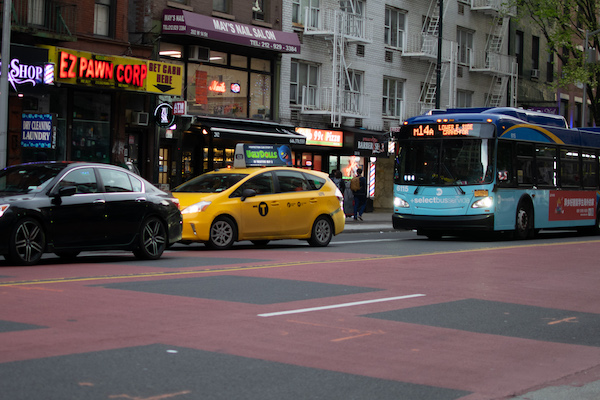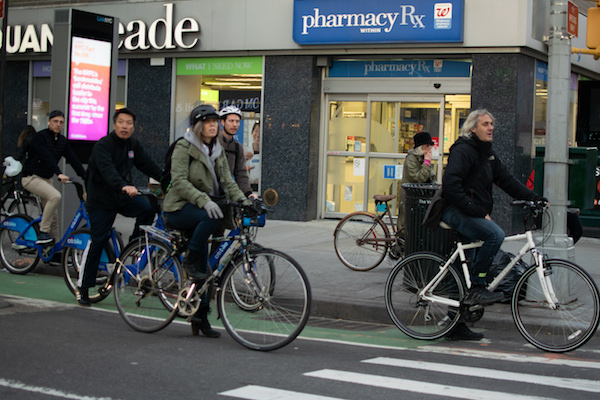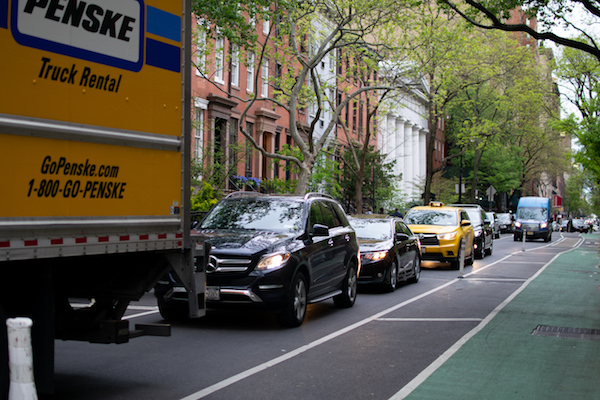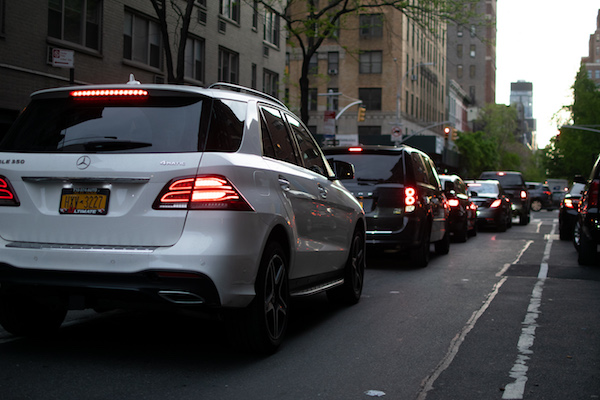
BY SAM BLEIBERG | Transit riders experienced their new normal for the foreseeable future, as the L Train began reduced service this past weekend.
As riders to and from Chelsea scramble to find alternatives to travel across town, the fight over mitigation efforts on 14th St. continues. A group of elected officials representing Chelsea released a statement raising concerns over the decision to prioritize buses and trucks on 14th St., reigniting a debate over the fate of a key transit corridor during the service adjustment and beyond.
Last Friday evening (April 26), the L Train service reduction plan began, with trains running once every 20 minutes over the weekend. The MTA and NYC Department of Transportation (DOT) mitigation plan in Manhattan centered around 14th St., where the agencies originally proposed restricting private vehicle traffic and prioritizing buses to efficiently move transit riders across town. The switch from a full shutdown to a service reduction placed the fate of the busway in question. On April 24, just days ahead of the service reduction’s start, the mayor announced the city will proceed with a busway on 14th St.
The uncertainty surrounding the busway has already taken a toll. While the bus lanes were painted months ago, work was halted after the announcement of the L Train service reduction. This delay resulted in the busway not being ready for the start of the service reduction, and travelers felt the pain this past weekend. The MTA recommended former L Train riders within Manhattan take the bus, but the already-slow M14 line left riders disappointed.

After weeks of silence on the issue, local electeds, including District Three Councilmember (and NYC Council Speaker) Corey Johnson, put out a joint statement on the announcement of the busway. The statement expressed skepticism over the busway, and concerns about how residents might be affected by traffic. The statement did not mention the expected impact on congestion on side streets in the absence of a busway.
Signed by Congressman Jerrold Nadler, State Senator Brad Hoylman, Assemblymember Richard N. Gottfried, Assemblymember Deborah J. Glick, and Johnson, the statement begins:
“The decision by the New York City Department of Transportation and MTA to pilot a Transit/Truck Priority lanes on 14th Street raises many concerning issues for our constituents who reside on the blocks to the immediate north and south of 14th Street. Our constituents have serious concerns, which we share, about the impacts of this plan on our neighborhoods, including how rerouted traffic could impact local side streets.”
The statement marked a shift for Johnson in particular, who, until now, has championed solutions to prioritize public transportation, including busways. During his State of the City Address, Johnson called for 30 miles of new, dedicated bus lanes to be built every year. The recent statement, however, does not mention the benefits of busways or celebrate the implementation of the busway in any way. In fact, the statement calls for strict characterization of the busway as a “true pilot program”—a concept that was not previously mentioned in the context of a call for more bus lanes.
Notably, last week’s statement was the first proactive comment on the L Train mitigation plan for Johnson in weeks, although he did exchange tweets expressing that his concerns that the busway may be mollified with congestion pricing. There was no mention of congestion pricing’s expected effect in the latest statement.

Johnson’s statement also contrasts with the approach of his colleagues in the City Council. Members from the east side of the L Train corridor in Manhattan were early supporters of the 14th St. busway, and put out statements celebrating the announcement of the plan to proceed with the busway. Manhattan Borough President Gale Brewer had also called for maintaining the plan for the busway.
Public transportation advocates, including the Riders Alliance and Transportation Alternatives, had hailed the busway as a victory for public transit riders, and a broader reevaluation of how the city might allocate public space to deprioritize private vehicles in favor of more efficient and accessible transportation options.
The statement from elected officials echoes the message of the 14th Street Coalition, who have opposed the busway on the grounds that it inconveniences residents around 14th St. The coalition’s recent statement on the busway announcement (as seen on the home page of their website) reveals the stark contrast between those who use 14th St. as a way to travel, and those who live on or near it: “So the Mayor is saying that helping a commuter save 15 minutes travel time is more important than the quality of life issues of those of us who live here.”

In an April 15 letter to DOT Manhattan Borough Commissioner Ed Pincar and NYC Transit President Andy Byford, the Transportation Planning Committee of Community Board 4 strongly supported the busway, unanimously passing a resolution that called for prioritizing buses and trucks, with a provision to evaluate banning thru-vehicular traffic.
After months of uncertainty, the busway on 14th St. has already been delayed past the start of L Train service reduction. Last week’s statement from elected officials falls short of a vote of confidence, and veers into skepticism—leaving the door open to more debate about, as the statement concludes, “what’s best for residents, businesses, mass transit users, pedestrians and cyclists.”

Chelsea Community News is made possible with the help of our awesome advertisers, and the support of our readers. If you like what you see, please consider taking part in our GoFundMe campaign (click here). To make a direct donation and/or send feedback about the site, send an email to Scott@chelseacommunitynews.com.

Pingback: ซอฟต์แวร์บริหารงานบริการทำความสะอาด
Pingback: thuốc nổ
Pingback: penis envy strain
Pingback: click here
Pingback: ซิเดกร้า
Pingback: ทีเด็ดบอลรอง
Pingback: https://www.dallasnews.com/marketplace/2023/09/29/phenq-reviews-legit-diet-pills-or-fat-burner-scam/
Pingback: Buy Magic Mushroom Online Australia.
Pingback: Fragrance Store in Portland Oregon
Pingback: roof skylight
Pingback: weed delivery toronto
Pingback: Order DMT online Melbourne
Pingback: บาคาร่า
Pingback: Ufa191 บาคาร่า
Pingback: Multiple streams of income
Pingback: pour apprendre plus
Pingback: aller à
Pingback: 토토백화점
Pingback: buy ayahuasca tea online therapy,
Pingback: dumps shop
Pingback: sbobet
Pingback: cardcc shops
Pingback: สล็อตวอเลท ไม่มีขั้นต่ำ
Pingback: buy cz guns USA online
Pingback: Esport
Pingback: bettilt giris
Pingback: DARK0DE MARKET URL
Pingback: dark0de market link
Pingback: ซ่อมรถบรรทุก
Pingback: kurumsal sunucu yapılandırma